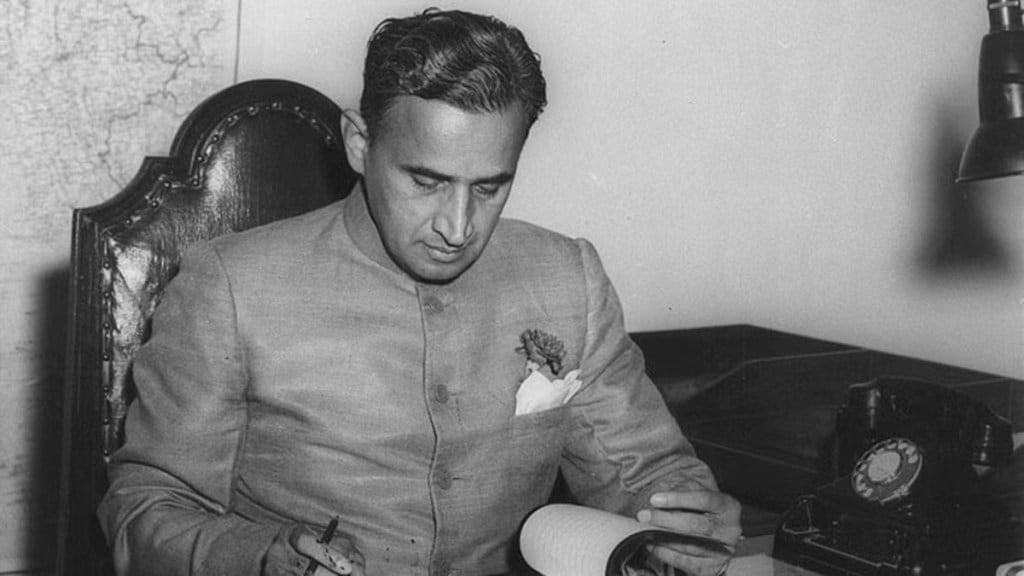By G Sreekumar
CD Deshmukh was the third governor of the Reserve Bank of India (RBI) and the first Indian to hold the position, from 1943 to 1948. It is less known that in 1947-48, the currency notes he signed were, with the probable exception of the British pound and the US dollar, legal tender in a maximum number of countries. Besides India, these included neighbours such as Nepal and Bhutan, former British protectorates in the Gulf, including the Trucial States, Bahrain, Kuwait, and the Sultanate of Oman, as well as Burma (hived off from India in 1937), and Pakistan. He took these additional responsibilities very seriously. In particular, he went out of the way to safeguard Pakistan’s interests.
The Pakistan (Monetary System and Reserve Bank) Order, issued on August 14, 1947 — the day Pakistan became independent, one — made detailed arrangements for transferring the RBI’s functions to a new central bank for Pakistan. The RBI would manage Pakistan’s public debt and exchange control operations until March 31, 1948, and also remain the banker to the Pakistan government and have the sole right to issue currency notes until September 30, 1948.
Not long after Partition was announced, Deshmukh summoned a young Muslim officer from the bank’s Department of Research and Statistics. Deshmukh established this star-studded department in 1945. He would establish a similar department in Delhi when he became finance minister, taking along a few from the RBI.
Hamza Alavi, the young research officer that he had summoned, had opted for Pakistan after Partition. He was born into a traditional Bohra family in Karachi, Pakistan’s commercial capital. Karachi was also the political capital till 1957, before it shifted to Rawalpindi and, later, Islamabad. The central bank, the State Bank of Pakistan (SBP), is still headquartered in Karachi. Alavi had an MA in economics from Aligarh Muslim University, and joined the Gokhale Institute of Politics and Economics in Pune for doctoral studies.
One day in 1945, professor DR Gadgil, his supervisor, called Alavi and said the RBI had inquired about recruiting talented scholars to join its new research division. Alavi replied his interest was in academics. Gadgil chided him, saying, “Young man, you had better learn something about life before you start teaching.” He added that the salary at the RBI was much higher than a university lecturer could hope to get, and he could always return to academics. Thus, Alavi became one of the early recruits of the RBI’s Department of Research and Statistics.
The bank’s central office, then housed in the present Main Building in Fort, Mumbai, was relatively small. Deshmukh had a soft corner for the research division he’d created. When Alavi presented himself before the governor in his first-floor corner office, Deshmukh observed only a few Muslim officers had opted for Pakistan. Its new central bank would have problems unless it had trained officers. Deshmukh said research was a luxury and persuaded Alavi against it. The new central bank would want officers trained in operational areas instead. Foreign exchange was the major challenge then. Even after allowing for those who opted for India, the bank’s Karachi, Lahore, and Dacca offices had staff experienced in currency, banking, and agricultural credit, the other core functions. Deshmukh put Alavi on intensive training with the bank’s Exchange Control Department created in 1939.
After Partition, Alavi was to remain with the RBI until July 1, when the SBP would start functioning. But he returned to Karachi to work at the RBI office there. In March 1948, Alavi set up a de facto headquarters for exchange control. This helped the SBP to be in readiness when it was finally established. Over the next few years, by leveraging his “ignorance”, as he claimed, he was able to view things from a fresh perspective. He deviated from the established policies and procedures which, in his view, were designed to serve British interests.
In 1950, still in his late 20s, Alavi rewrote SBP’s Exchange Control Manual. According to him, the RBI copied these innovations. A challenging stint in Dacca followed. As in-charge of exchange control operations, he had to deal with deeply entrenched and powerful lobbies. There were also challenges in accounting for trade across borders drawn on rivers and marshy land. After this, he became secretary to the central board of SBP. He resigned in May 1953 to pursue his first love of academics.
After leaving the SBP, Alavi registered for a PhD at the London School of Economics to research banking in Pakistan. But he soon grew bored with the topic, becoming “disenchanted with empty academicism”, and shifted focus to attending lectures and seminars on politics, sociology, and social anthropology. A period of activism followed, during which he founded and edited Pakistan Today (1957-62) and brought in several eminent leftist speakers to speak at fora. He also helped found The Forum, a group of socialists from third-world countries, and worked as a farmer, living among peasants in Tanzania. He turned to full-time academics in 1966, teaching at the Institute of Development Studies, Sussex, and the universities of Leeds and Manchester before retiring in 1989. After that, he lectured at varsities in the US and other countries before returning to Karachi.
In the preparatory work towards Pakistan joining the International Monetary Fund, Deshmukh ensured it got a quota of $100 million without reducing India’s share of $400 million. In his autobiographical Fragments of a Life, Alavi wondered: “It is interesting that a Maharashtrian Brahmin was so concerned whether the State Bank of Pakistan would be able to function properly or not. Why should he care?”
The writer is a former central banker.
Disclaimer: Views expressed are personal and do not reflect the official position or policy of FinancialExpress.com. Reproducing this content without permission is prohibited.


